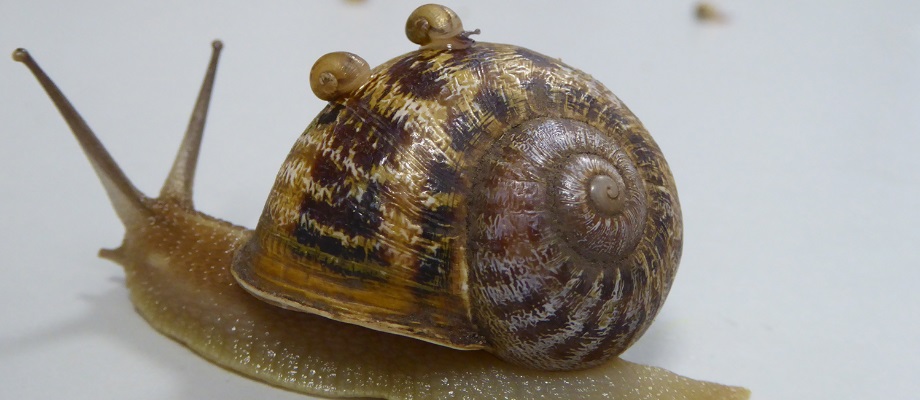
The slither of tiny feet – rare ‘lefty’ snails produce offspring
May 18th, 2017
Two rare ‘lefty’ snails brought together following a public appeal by a scientist at the University of Nottingham have produced their first offspring.
More than 170 baby snails have hatched, just six months after the story of Jeremy the garden snail and his search for a similarly left-coiling, or sinistral, companion hit international headlines.
Two potential mates were found for Jeremy following an appeal on BBC Radio 4’s Today programme by Dr Angus Davison from the University’s School of Life Sciences. Dr Davison wanted to breed from Jeremy to find out whether the genetics of these rare snails could offer insight into the body asymmetry in other animals, including humans.
But in a tragic twist, the original snail was left shell-shocked after being given the cold shoulder by both of his suitors — dubbed Lefty and Tomeu — who instead mated with each other.
The first batch of eggs to hatch were ‘fathered’ by Lefty and laid by Tomeu in April – snails are hermaphrodites so can fulfil the role of either mother or father.
The hatching was eagerly anticipated by Dr Davison, who was keen to find out whether the tiny gastropods would follow in the left-coiling footsteps of their parents. However as the new-borns developed it became apparent that every single one has the less rare form of right-coiling, or dextral, shells.
Dr Davison said: “Despite not yet being able to mate Jeremy, we have been able to answer the question of which direction the shells would coil in offspring from two of these rare left-coiling variants. Was it a chance event that made these snails develop as mirror images, or is it inherited?
“The fact that the babies developed right-coiling shells may be because the mother carries both the dominant and recessive versions of the genes that determine shell-coiling direction. Body asymmetry in snails is inherited in a similar way to bird shell colour – only the mother’s genes determine the direction of the twist of the shell, or the colour of a bird egg. It is far more likely that we will get to see left-coiling babies produced in the next generation or even the generation after that.”
Last year, Dr Davison and colleagues at universities in Edinburgh, Germany and the US, revealed they had discovered a gene that determines the direction in which a snail’s shell twists. The same gene also affects body asymmetry in other animals — including humans — and research using these snails could offer the chance to develop our understanding of how organs are placed in the body and why this process can sometimes go wrong when some or all of the major internal organs are reversed from their normal placement.
Two more batches of eggs — another laid by Tomeu and one laid by Lefty and fathered by Tomeu — will soon be hatching. Lefty has recently returned home but Dr Davison remains hopeful that Jeremy may still be encouraged to mate with Tomeu and that the resulting offspring from the combination of pairings may be mated. In the long term, these crosses may then be used to map and find the genes that determine variation in left-right asymmetry.
Click here for a video of a lefty snail and baby.
Tags: academic research, angus davison, genetics, jeremy the snail, lefty snail, School of Life Sciences
Comments are closed.
Other

Need news? See you on SharePoint
After 14 years of service, Campus News is being retired as the university’s staff news platform. […]

Roads and car parks closed for refurbishing work
As part of ongoing road improvements at the university, works will be taking place to resurface […]

